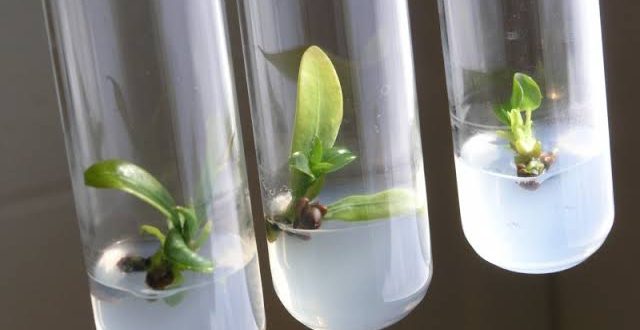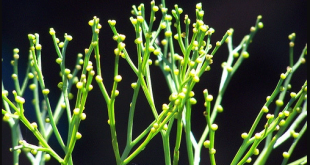What is embryo culture?
Embryo culture is the sterile isolation and growth of an immature or mature embryo in vitro with the goal of obtaining a viable plant.
Embryo rescue technique in overcoming barriers of distantly related crops:
Distant hybridization: Hybridization between individuals from different species, belonging to the same genus or to different genera is termed distant hybridization, such crosses are known as distant crosses or wide crosses.
- Individuals use for hybridization in such cases are taxonomically more distantly related than different varieties from the same species.
- The first authentic record of a distant hybridization for crop improvement was the production of a hybrid between carnation (Dianthus caryophyllus) and sweet william ( Dianthus barbatus) Thomas Fairchild in 1717.
- An interesting inter-generic hybrid, Raphanobrassica, was produced by a Russian scientist, Karpechenko in 1928. Raphanobrassica is the amphidiploid from a cross between radish(Raphanussativus)and cabbage (Brassica oleracea).
- Triticale was first produced by Rimpau in about 1890. It is an amphiploid obtained from crosses between wheat(Triticum aestivum) and rye (Secale cereale). It is now becoming an accepted crop in certain areas e.g. in Canada.
Barriers to the production of Distant Hybrids
Failure of zygote formation
- In many cases, distant hybrids are not produced because the zygote is not formed due to the failure of fertilization.
- Fertilization often fails because the pollen tube is unable to reach the embryo sac and consequently the sperms are not available for fertilization. For example in crosses between maize (Zea mays) and Tripsacum sp.
Failure of zygote development: In many cases, fertilization doesn’t take place and the zygote is formed. But the development of the zygote is blocked at various stages. Failure of embryo development may take place due to :
- Lethal genes
Some species carry a lethal gene that causes the death of the zygote during early embryonic development. Such lethal genes generally don’t have any effect on the species carrying them but affect only interspecific hybrid embryos e.g. Aegilo umbellulata has a gene for lethality that has three alleles. This lethal gene is active against the zygote produced by crossing A. umbellulata with diploid (2x) wheat ( T. aestivum).
Similarly, Crepis tectorum has a lethal gene “I” which causes the death of embryos in the early stages of development in certain interspecific crosses.
Genotypic disharmony between the two parental genomes:
- In some cases, the death of embryos may occur due to genetic imbalance rather than the action of species’ lethal genes.
- Genotypic disharmony occurs in interspecific crosses in cotton. The hybrids from these crosses die in various stages of development ranging from early embryonic development to the reproductive phase of the F1 plant.
Application of embryo culture:
History
Haning(1904) Embryo culture of selected crucifers.
Robbins(1922), Kotte in vitro culture of root tips.
Laibach’s( 1952) use of embryo culture technique in inter-specific crosses of Linum.
Embryo culture:
In embryo culture, young embryos are removed from developing seeds and placed on a suitable nutrient medium to obtain seedlings.
So far, it has not been possible to culture embryos before a certain stage of development, e.g. before the globular stage in the case of barley.
Embryo culture is being routinely used in some crop improvement programs to obtain interspecific hybrids.
It has some other specific uses as well, e.g propagation of orchids, and overcoming dormancy.
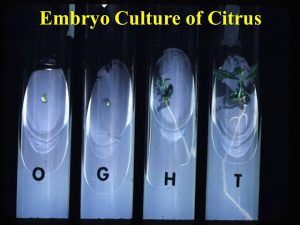
- Immature zygotic embryos are excised and cultured in vitro to obtain viable seeds.
- Used in abortive inter-specific crosses e.g. potato.
- Used for embryos lacking endosperm ( orchids)
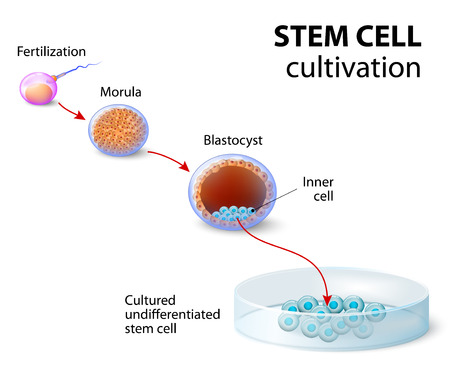
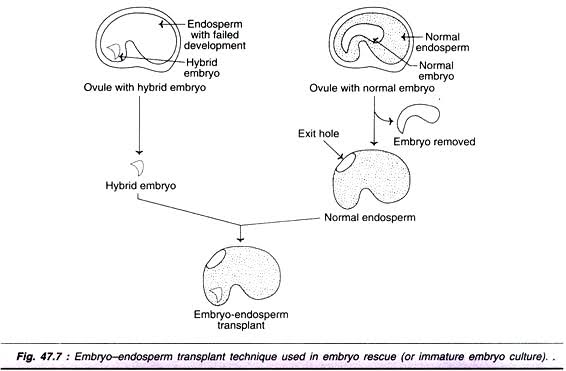
Elimination of the (absolute) inhibition of seed germination:
In a few species, it is absolutely impossible to obtain germination in vivo and in these cases embryo culture is essential, e.g Colocasia esculenta, Musa balbisiana, and the hybrid of Pinus armandii and P. Koraiensis.
Recovery of distant hybrids:
Distant crosses may fail due to one or more several reasons. e.g.
• Inability of pollen to germinate, failure of the pollen tubes to grow, or perhaps more commonly due to the degradation of the endosperm.
• When an embryo fails to develop due to endosperm degeneration, embryo culture is used to recover hybrid plants. Embryo culture has been widely used for this purpose. e.g. Recovery of hybrid from Hordeum vulgare and Secale cereale, Triticum aestivum and Agropyran repens, Hordeum vulgare, and Triticum species including T. aestivum. In the case of Triticale, a rare combination between Triticum and cereale develop viable seeds.
Chromosome elimination
In some cases of distant hybridization, chromosomes are gradually eliminated from the zygote.
• Chromosome elimination has been reported in certain interspecific crosses in Nicotiana and Hordeum and in crosses between Triticum aestivum and Hordeum vulgare.
• When Hordeum vulgare or T. aestivum are used as male and Hordeum bulbosum is used as female, the embryos obtained from such crosses are generally haploid carrying the haploid genomes of H. vulgare and T. aestivum, respectively.
• In fact this cross was the basis for large-scale haploid production programs in barley.
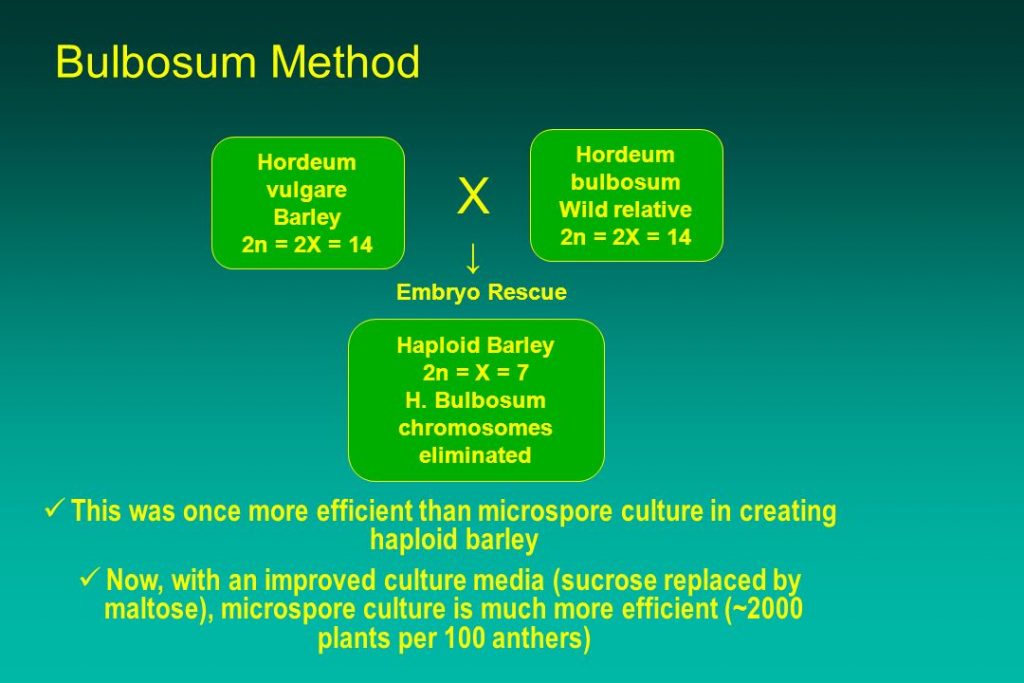
Incompatible cytoplasm
In a few cases, embryo development may be blocked by an incompatibility between the cytoplasms of the species used as female and the genome of the species used as male. Such an interaction more generally, leads to hybrid weakness and male sterility in the hybrids. In a few cases, embryo development may also be prevented.
Failure of hybrid seedling development
Some species’ hybrids die during seedlings’ development or even after the initiation of flowering. Some interspecific hybrids in Meliotus are chlorophyll deficient and fail to survive, e.g. certain interspecific hybrids of cotton. Such plants may be grown to maturity by grafting them onto normal plants or by growing them in vitro.
Interspecific hybridization between Corchorus olitorius and Corchorus capsularis
• Hybrid seeds obtained using C. olitorius as female with the application of a high concentration of IAA at the pedicel of the pollinated flower.
• Grafting was also necessary.
• Embryo culture was needed to recover the hybrid.
Propagation of Orchids
Orchids are difficult to propagate since their seeds lack any stored food and the embryo is virtually naked. In many orchids, embryo development is incomplete at the time the seeds mature. Young or mature orchid embryos are removed from seeds and placed on suitable nutrient media. The embryos develop into seedlings either directly or through callus formation.
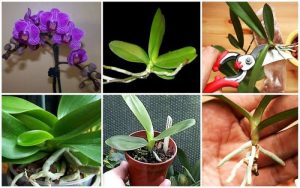
Shortening of the Breeding cycle
• There are many species that exhibit seed dormancy which is localized in the seed coat and/ or in the endosperm. By removing these the seeds germinate immediately.
• In some fruit trees, embryos require a period after ripening before germination. Iris seeds may take two or several years to germinate. This period of dormancy can be effectively eliminated by embryo culture. Other examples are Prunus, Taxus, etc.
Rescuing incompatible hybrid crosses
sexual incompatibilities have been separated into pre and post-fertilization barriers.
• The pre-fertilization barrier is usually due to inhibition of pollen tube growth by the stigma or supper style, circumvented by using the cut style technique or in vitro pollination.
• Post-fertilization barriers frequently result from the failure of the hybrid endosperm to develop properly, leading to starvation and abortion of the hybrid embryo or resulting from embryo-endosperm incompatibility where the endosperm produces toxins that kill the embryo.
In vitro plant regeneration:
Hybrid plantlets can be obtained by growing the immature zygotic hybrid embryos directly into seedlings or propagating them as clones of hybrid plantlets.
Factors affecting the success of embryo culture
• Genotype
• Developmental stages of the embryo at isolation
• Growth conditions of the mother plant
• Composition of the nutrient media
• Oxygen supply
• Light
• Temperature
 Plantlet The Blogging Platform of Department of Botany, University of Dhaka
Plantlet The Blogging Platform of Department of Botany, University of Dhaka
